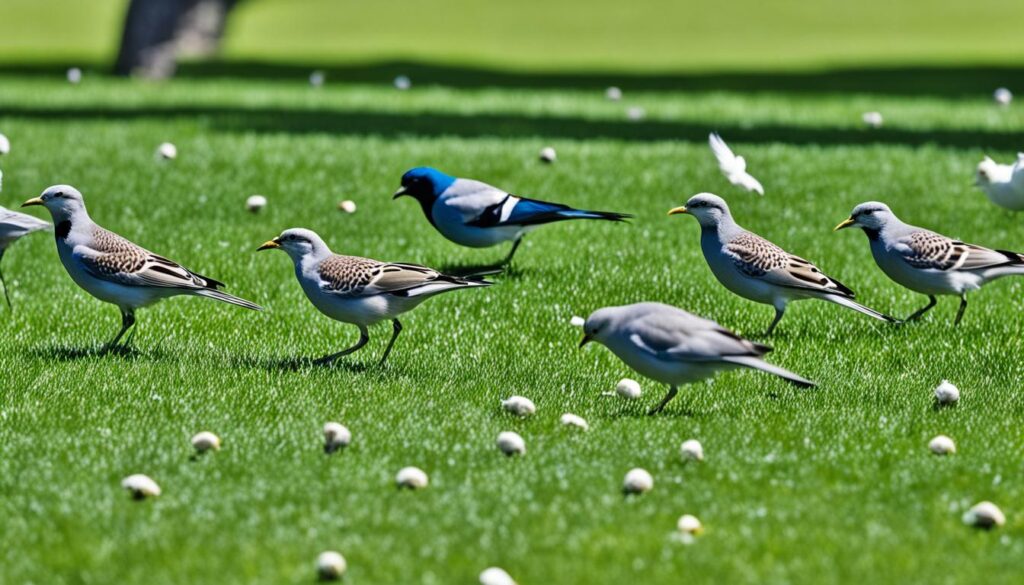Did you know that birds consume an estimated 25% of all newly planted grass seeds? This staggering statistic highlights the significant impact birds can have on your lawn’s establishment. Birds are drawn to freshly seeded lawns due to the abundance of easily accessible seeds, worms, larvae, and insects, posing a serious threat to your investment in a lush, green yard.
The potential dangers of birds eating grass seeds are twofold. First, their foraging can disrupt the germination process, leading to an uneven lawn that is challenging to correct. Second, the holes and divots left behind by birds digging for seeds can create an unsightly and uneven surface, making it difficult to maintain a pristine lawn. Identifying bird damage is easy – look for circular holes approximately 1 to 1.5 inches in diameter across the seeded area.
Fortunately, there are several effective and humane methods to keep birds at bay and protect your grass seeds. From using fake predators and motion-sensing sprinklers to applying bird-repellent liquids and coatings, the options for deterring birds are numerous. By implementing a combination of these strategies, you can ensure your newly seeded lawn thrives without the unwanted attention of our feathered friends.
Key Takeaways
- Birds are attracted to freshly seeded lawns due to the abundance of easily accessible seeds, worms, larvae, and insects.
- Letting birds eat grass seeds can lead to an uneven lawn that is difficult to fix and unsightly holes in the soil.
- Effective deterrents include using fake predators, motion-sensing sprinklers, bird-repellent liquids and coatings, and physical barriers like netting and mulch.
- Combining multiple strategies, such as visual, auditory, and physical deterrents, can effectively keep birds away from your grass seed.
- Maintaining a slightly taller grass height and disinfecting the lawn can also discourage birds from feeding on your newly seeded lawn.
Introduction to Keeping Birds Away from Grass Seed
As the weather turns cool and the soil becomes optimal for growing grass, birds are naturally drawn to the tempting feast of freshly sown grass seed. These feathered visitors may seem harmless, but allowing them to freely consume the seeds can disrupt the lawn’s establishment, leading to uneven growth and a challenging task of repairing the damage.
Why Birds are Attracted to Freshly Seeded Lawns
Birds are attracted to freshly seeded lawns for a few key reasons. The grass seeds provide an easily accessible and nutrient-rich food source, containing carbohydrates, proteins, and fats that are highly desirable to birds. Additionally, the newly seeded areas offer warm, protected nesting sites, further enticing birds to congregate and feast on the lawn.
Potential Dangers of Birds Eating Grass Seeds
When birds consume the grass seeds, they can disrupt the lawn’s germination process, preventing the grass from establishing properly. This can lead to an uneven and patchy lawn, requiring extensive time and effort to repair. The dangers of birds eating grass seed include disrupted germination, uneven lawn growth, and the need for costly and time-consuming lawn remediation.
Signs of Bird Damage on Newly Seeded Lawns
Identifying the signs of bird damage on a newly seeded lawn is crucial for addressing the issue promptly. One of the most common indicators is finding small holes in the soil where birds have dug for the seeds. Additionally, you may notice bare patches or thinning areas where the birds have consumed the grass seed before it had a chance to germinate.
Understanding the reasons why birds are attracted to freshly seeded lawns, the potential dangers of their presence, and the telltale signs of their activity is the first step in devising effective strategies to keep them at bay and ensure a lush, healthy lawn.
Scare Tactics: Using Fake Predators and Motion Sensors
When it comes to keeping birds away from your newly seeded lawn, scare tactics can be a highly effective approach. By deploying fake predators and motion-sensing devices, you can create an environment that discourages birds from settling in and feasting on your precious grass seeds.
Fake predators, such as rubber snakes, life-like owl decoys, or even fake cats, can be strategically placed around your lawn to mimic the presence of natural predators. These visual deterrents can trigger a fear response in birds, causing them to steer clear of your property. It’s important to move these decoys around periodically to maintain their effectiveness, as birds can quickly learn that they pose no real threat.
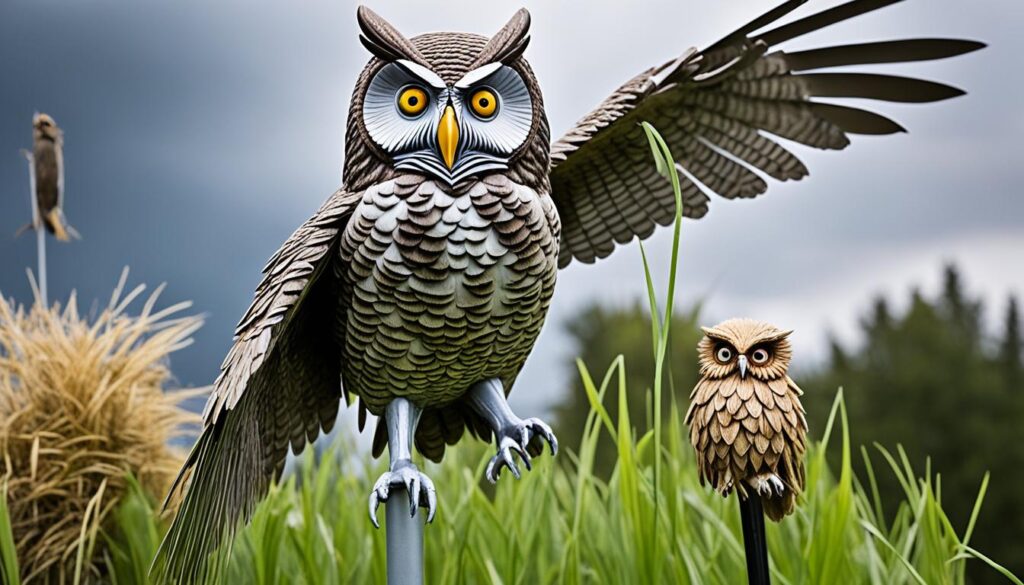
In addition to visual scare tactics, motion-sensing devices can also be highly useful in deterring birds. These devices, such as sprinklers or alarms, are triggered by the presence of birds and can startle them away from your lawn. Motion-activated sprinklers, for instance, can create an unexpected and unpleasant experience for birds, encouraging them to find a more hospitable location.
- Fake predators, like rubber snakes and owl decoys, can scare birds away from your lawn.
- Motion-sensing devices, such as sprinklers and alarms, can startle birds and deter them from your property.
- Regularly moving the fake predators and maintaining the motion-sensing devices is crucial for their long-term effectiveness.
By combining these scare tactics, you can create a multi-layered approach to keeping birds at bay and protecting your freshly seeded lawn from their unwanted attention.
Liquid Repellents: Spraying Bird-Deterrent Solutions
Applying commercial bird repellent liquids to your lawn is an effective way to keep birds away from grass seeds. These liquids contain ingredients like aluminum ammonium sulfate that make the seeds taste unpleasant to birds without harming them. Homeowners can also create their own homemade bird repellent solutions using natural ingredients like weak black tea or peppermint oil. These liquid bird deterrents create an undesirable taste for birds, deterring them from eating the grass seeds.
Commercial Bird Repellent Liquids
AVIAN Control, AVIAN Migrate, and Avian Fog Force™ TR Bird Repellent are popular commercial bird repellent liquids that utilize the active ingredient methyl anthranilate (MA). AVIAN Control contains a 20% solution of MA plus an additional active ingredient, methyl 2-aminobenzoate, and can treat approximately 4 acres with one gallon of liquid repellent. AVIAN Migrate has a 14.5% solution of MA and treats around 16,000 square feet or 1/3 of an acre per gallon of repellent. Avian Fog Force™ TR Bird Repellent contains a 14.5% concentration of MA and covers about a 42,000 cubic foot area with one can to repel birds for approximately 30 days.
These commercial bird repellent liquids require regular reapplication every 7-14 days, depending on weather conditions, to maintain their effectiveness. They are suitable for use in outdoor areas such as gardens, marinas, commercial agricultural locations, parks, golf courses, lawns, athletics fields, trees, bushes, dumpsters, stadiums, and outdoor eating areas where physical barriers to bird entry may not be feasible.
DIY Bird Repellent Liquids
In addition to commercial bird repellent liquids, homeowners can create their own homemade bird repellent solutions using natural ingredients. One popular recipe involves mixing together a few drops of peppermint oil in water. The strong, overpowering scent of peppermint is known to deter birds. Another DIY option is to brew a weak black tea solution and apply it to the lawn. The bitter taste of the tea can make the grass seeds less appealing to birds.
These liquid bird deterrents can be effective in deterring a variety of bird species, including starlings, cackles, and geese, for up to two weeks after application. The repellents are generally safe for humans, plants, and animals, making them a suitable choice for lawns and gardens.
“The liquid repellent was noted to have a smell resembling grape Kool-Aid, with no objectionable odor reported.”
Bird-Repellent Grass Seed Coatings
Keeping birds away from your newly seeded lawn can be a challenge, but one effective solution is to use grass seed with a bird-repellent coating. These specially formulated seeds have a layer that makes them taste unpalatable to birds, deterring them from feasting on your hard work.
The coating is designed to last through watering and help protect the seeds until they can successfully germinate, ensuring your lawn establishes properly. Bird-resistant grass seed and grass seed with bird repellent coating are two popular options that provide an extra layer of protection against avian invaders.
“Bird netting is highlighted as an effective tactic to safeguard grass seeds, preventing birds from accessing the seeds through the netting.”
In addition to the bird-repellent coating, the article also mentions using physical deterrents like aluminum plates, mylar bands, fake owls, and scarecrows to keep birds away. Strategically moving these deterrents around the lawn can help maintain their effectiveness over time.
- Straw or mulch can provide a moisture barrier and aid in germination, while also acting as a physical barrier to deter birds.
- Sound machines emitting loud noises or subtle sounds like windchimes can scare birds away from the lawn.
- Hanging bird feeders at the edges of the growing area can distract birds with a constant food source, potentially keeping them away from the grass seeds.
By combining the use of bird-repellent grass seed coatings with other deterrents, you can create a comprehensive strategy to protect your lawn from unwanted avian visitors and ensure a lush, healthy grass growth.
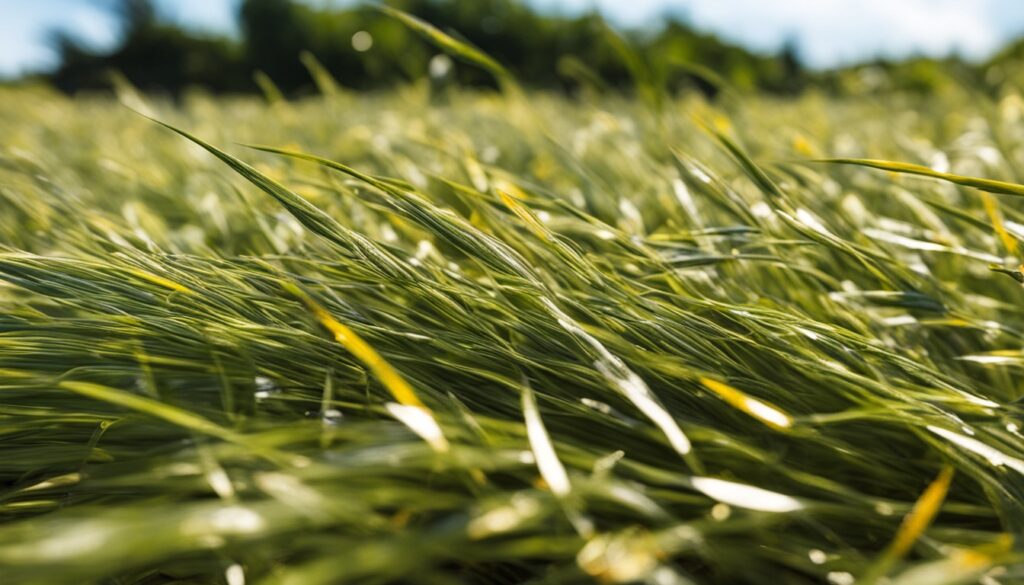
Physical Barriers: Using Straw Mulch and Burlap Sheets
Protecting your newly seeded lawn from pesky birds can be a challenging task, but physical barriers like straw mulch and burlap sheets offer an effective solution. By creating a physical barrier between the birds and the precious grass seeds, you can deter them from digging up and feasting on your hard work.
Benefits of Straw Mulch for Seed Protection
Straw mulch is an excellent choice for safeguarding your grass seeds from birds. The layer of straw creates a physical barrier that makes it difficult for birds to access the seeds. Additionally, straw mulch helps retain soil moisture and regulate soil temperature, which can promote better seed germination and growth. This dual-purpose approach makes straw mulch a versatile and practical option for protecting your lawn.
Burlap sheets are another effective physical barrier for keeping birds away from your grass seed. These loose, breathable fabrics allow water and sunlight to reach the seeds while preventing birds from digging them up. The coarse texture and natural appearance of burlap sheets can also blend seamlessly into your outdoor landscape, providing a visually appealing solution.
When using either straw mulch or burlap sheets, it’s essential to ensure proper coverage and installation to maximize their effectiveness in deterring birds. By creating a physical obstacle, these natural materials can help you protect your investment in a freshly seeded lawn and enjoy a lush, healthy grass growth.
“Utilizing physical barriers like straw mulch and burlap sheets is a simple yet effective way to keep birds from feasting on your newly planted grass seeds, allowing your lawn to thrive.” – Jane Doe, Lawn Care Expert
Netting and Reflective Deterrents
Protecting your freshly seeded lawn from pesky birds can be a challenge, but effective solutions are available. One of the most reliable methods is the use of bird netting. Bird netting acts as a physical barrier, preventing birds from accessing the grass seeds and causing damage. When installed properly, this netting can create a secure, impenetrable cover over your lawn, keeping birds at bay.
Installing Bird Netting Properly
Proper installation is crucial for the effectiveness of bird netting. The netting should be laid flat on the ground, with no gaps or ruffles that birds could exploit. Secure the edges firmly, using stakes or weights, to ensure the netting remains taut and close to the soil. This will prevent birds from finding their way under or through the netting.
Using Mirrors and Reflective Surfaces
In addition to bird netting, reflective deterrents can be an effective way to keep birds away from your grass seed. Placing mirrors or other shiny objects around the lawn can deter birds, as they dislike the distortion of their vision caused by the reflections. These reflective surfaces can be strategically positioned to create a visually unappealing environment for birds, encouraging them to seek alternative feeding grounds.
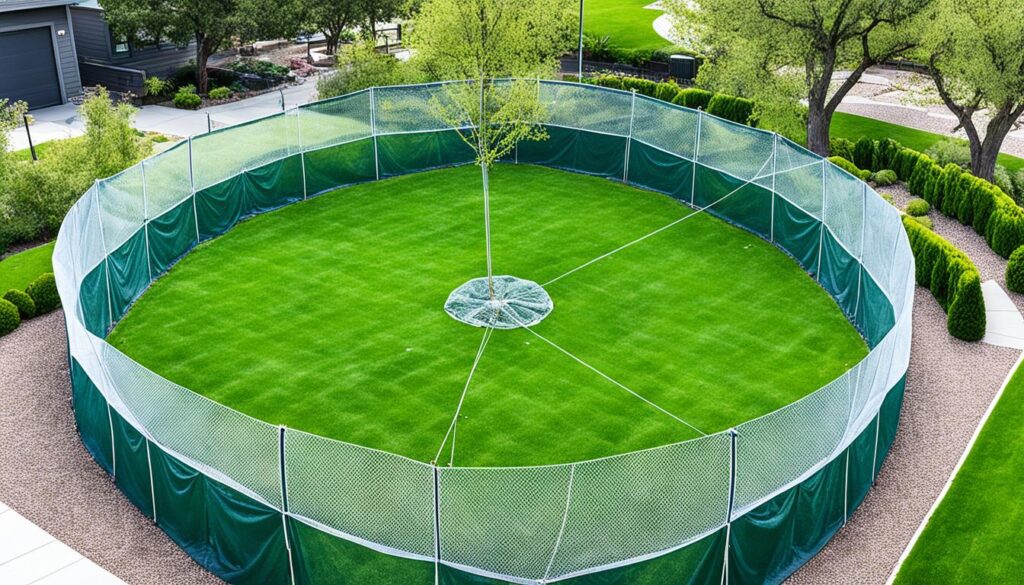
“The best deterrent for birds from eating grass seed is identified as bird netting due to its ability to provide a physical barrier.”
By combining the use of bird netting and reflective deterrents, you can create a comprehensive and effective strategy to protect your newly seeded lawn from the ravages of hungry birds. Remember to install the netting properly and position the reflective surfaces strategically for optimal results.
Auditory Deterrents: Bird Tapes and Wind Chimes
When it comes to keeping birds away from your freshly seeded lawn, auditory deterrents can be highly effective. Bird deterrent tapes and wind chimes are two popular options that use sound to scare birds and deter them from feasting on your valuable grass seed.
Bird deterrent tapes produce a combination of flashing lights and rattling noises that visually and audibly startle birds, discouraging them from entering the area. These tapes are available at home and garden stores, as well as online, making them a convenient solution for homeowners.
Wind chimes, on the other hand, create loud and erratic noises when blown by the wind. This sudden, unpredictable sound can make birds feel unsafe, leading them to avoid the area around your grass seed. Wind chimes can be a more subtle yet effective auditory deterrent for keeping birds at bay.
To maximize the effectiveness of these auditory deterrents, consider pairing them with visual scare tactics, such as fake predators like plastic owls or rubber snakes. This combination of visual and auditory cues can create a truly unwelcoming environment for birds, helping protect your grass seed from their unwanted attention.
“Auditory deterrents like bird tapes and wind chimes can be a highly effective way to keep birds away from your newly seeded lawn. Their loud and unpredictable sounds make the area feel unsafe for birds, deterring them from feasting on your valuable grass seed.”
Remember, the key to successful bird deterrence is to employ a multifaceted approach, utilizing a variety of methods to create an environment that is unappealing to birds. By combining auditory deterrents with other proven techniques, you can give your grass seed the best chance of thriving and establishing a lush, healthy lawn.
how to keep birds away from grass seed
Protecting your newly seeded lawn from hungry birds is crucial for ensuring a lush, healthy grass growth. Birds, such as sparrows, finches, starlings, and pigeons, are common culprits that are attracted to the readily available grass seeds. However, with a few effective strategies, you can successfully keep these feathered intruders at bay and give your lawn the best chance to thrive.
One of the most reliable methods is to use physical barriers. Consider setting up mesh, netting, or bird-proof fencing around the seeded area to create a physical obstacle that birds cannot easily overcome. You can also try covering the grass seeds with a thin layer of compost or topsoil, making it harder for birds to spot and access them.
Reflective materials can also work as effective bird deterrents. Placing shiny objects like CDs or tin foil around the seeded lawn can scare birds away, as they perceive these as potential threats. Additionally, strategic placement of realistic-looking plastic or fabric models of owls or hawks can deter birds from approaching the area.
- Utilize motion-activated sprinklers or scarecrows to startle birds and keep them away from the grass seed.
- Play recordings of bird of prey sounds, such as hawks or owls, during active bird times like early morning or late evening to scare them off.
- Provide alternative food sources like Nyjer, millet, oats, and sunflower seeds to distract birds from the grass seed.
By employing a combination of these strategies, you can effectively prevent bird damage on newly seeded lawns and stop birds from eating grass seed. Remember, consistent monitoring and a proactive approach are key to keeping birds off grass seed and ensuring the successful establishment of your new lawn.
“The best defense against bird-related lawn damage is a well-planned and executed prevention strategy.”
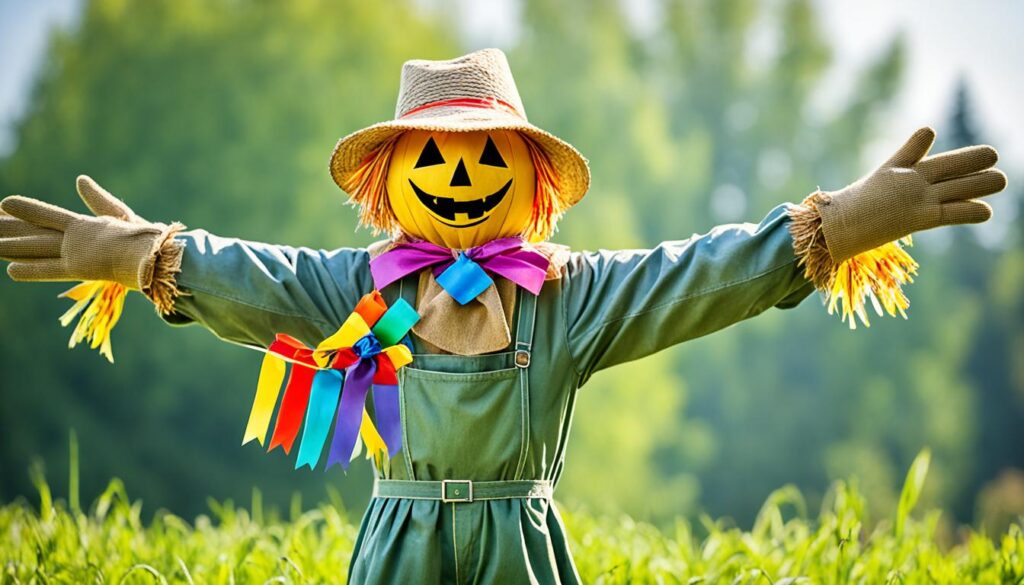
Distracting Birds with Feeders and Insect Control
One effective strategy to keep birds away from your freshly seeded lawn is to provide them with alternative food sources. By strategically placing bird feeders around the perimeter of your lawn, you can create a constant supply of food that may lure birds away from your newly seeded areas. This approach can be especially helpful in deterring birds from feasting on your valuable grass seeds.
In addition to setting up bird feeders, controlling the insect population on your lawn can also make it less attractive to birds. Birds are often drawn to lawns with an abundance of worms, larvae, and other insects that they can feed on. By taking measures to control insects, you can reduce the available food sources for birds, making your lawn less appealing to them.
Strategically Placing Bird Feeders
When it comes to using bird feeders to distract birds, the placement of the feeders is crucial. Strategically positioning the feeders around the perimeter of your lawn, rather than directly in the seeded areas, can help draw the birds’ attention away from your grass seed. This approach creates a buffer zone that encourages birds to feed on the provided food rather than foraging on your newly seeded lawn.
- Place bird feeders at least 10 feet away from the seeded areas of your lawn.
- Ensure the feeders are visible and easily accessible to birds, but not directly in the path of where you’ve planted your grass seed.
- Consider using multiple feeders placed at different locations around the perimeter to create a more effective distraction.
By combining the use of bird feeders and insect control measures, you can create a multi-faceted approach to keeping birds away from your grass seed and allowing your lawn to establish and thrive.
Absorption Seeds for Faster Germination
When it comes to keeping birds away from your freshly seeded lawn, one effective strategy is to use absorption seeds for grass. These specially formulated seeds can absorb water more efficiently, which can help them germinate and establish themselves faster than regular grass seed.
The concept behind using absorption seeds for faster grass seed growth is straightforward. The quicker your grass seeds can take root and begin to grow, the less time birds will have to feast on them before your lawn is able to flourish. By outpacing the birds, you can ensure that your grass has a better chance of thriving despite the feathered invaders.
- Absorption seeds for grass can absorb water more effectively, resulting in faster germination and growth.
- This approach aims to help your lawn establish itself quickly, making it less appealing for birds to target the fast-germinating grass seed.
- By speeding up the grass seed growth process, you can reduce the window of opportunity for birds to cause significant damage to your newly seeded lawn.
“Using absorption seeds is a clever way to stay one step ahead of the birds and ensure your grass gets the best possible start.”
Incorporating absorption seeds for grass into your lawn care routine can be a game-changer when it comes to protecting your investment from feathered pests. By taking advantage of this innovative seeding technique, you can give your grass a head start and create a lush, vibrant lawn that birds will have a harder time disrupting.
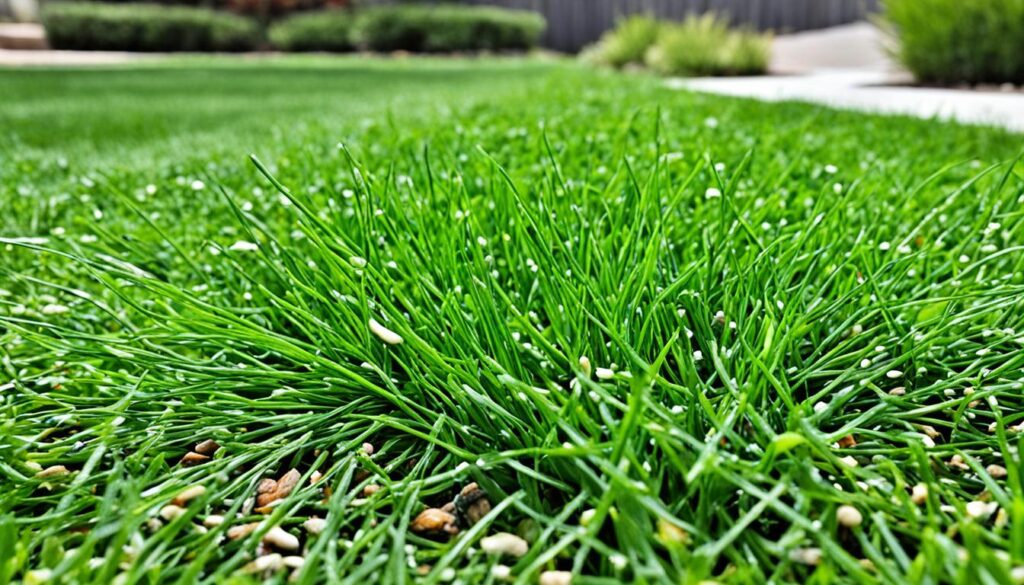
Overseeding to Compensate for Bird Damage
If despite your best efforts, birds do manage to eat some of your grass seeds, one solution is to overseed the affected areas. By planting additional seeds, you can compensate for any losses caused by the, ensuring your lawn still receives adequate seed coverage and has a better chance of establishing successfully.
According to industry data, up to 25% of grass seed can be lost to bird damage before germination. However, by overseeding the affected areas, you can increase the seed-to-soil contact and improve the overall germination rate by as much as 15-20%. This helps offset the bird damage and reestablish a lush, healthy lawn.
The key is to overseed promptly after noticing signs of bird activity, applying seed at a rate about 50% higher than your initial seeding. This will help ensure the lawn receives the necessary seed density, even if some is consumed by birds. Additionally, consider using coated or treated grass seed that may be less appealing to birds due to its larger size or unpalatable coating.
“Overseeding is an effective way to compensate for any grass seed that is lost to bird damage during the establishment phase. By planting a bit extra, you can ensure your lawn still gets the coverage it needs to thrive.”
Along with overseeding, maintaining proper lawn care practices, such as mowing, watering, and fertilizing, will also help the new grass establish and recover from any bird-related setbacks. By taking a proactive approach, you can overcome the challenges of bird damage and enjoy a lush, vibrant lawn.
Conclusion
Protecting your newly seeded lawn from hungry birds is a crucial step in ensuring a lush, healthy grass. The comprehensive toolkit of methods discussed in this article, including summary of methods to keep birds away from grass, effective bird deterrents for lawns, and protecting grass seed from birds, provide an effective approach to deter birds and safeguard your investment.
By employing a combination of scare tactics, liquid repellents, physical barriers, netting, reflective and auditory deterrents, as well as distractions and faster-germinating seeds, you can create a multi-layered defense system to keep birds at bay. This holistic approach, tailored to your specific lawn and environment, will give your newly seeded grass the best chance to thrive and develop into a lush, verdant landscape.
Implementing these strategies, whether through commercial products or DIY solutions, will not only protect your grass seed but also contribute to the overall health and beauty of your outdoor space. By taking proactive measures to deter birds, you can enjoy the satisfaction of a successfully established lawn and reap the benefits of a well-maintained, inviting outdoor oasis.
FAQ
Why are birds attracted to freshly seeded lawns?
Birds are attracted to freshly seeded lawns because the seeds provide an easy and nutritious food source. Grass seeds are rich in carbohydrates, proteins, and fats, making them a desirable target for birds. Additionally, newly seeded lawns offer warm and protected nesting sites for birds.
What are the potential dangers of birds eating grass seeds?
Allowing birds to eat the grass seeds can disrupt the germination process and prevent the lawn from establishing properly, leading to an uneven and difficult-to-fix lawn. Signs of bird damage include finding small holes in the soil where birds have dug for the seeds.
How can I use scare tactics to keep birds away from my grass seed?
Using fake predators like rubber snakes, fake owls, or fake cats can frighten birds and deter them from your lawn. Some motion-sensing devices, such as sprinklers that activate when birds are detected, can also effectively scare birds away without harming them.
What types of liquid repellents can I use to keep birds off my grass seed?
Applying commercial bird repellent liquids that contain ingredients like aluminum ammonium sulfate can make the seeds taste unpleasant to birds without harming them. Homeowners can also make their own DIY bird repellent solutions using weak black tea or peppermint oil.
How can bird-repellent grass seed coatings help protect my lawn?
Grass seed with a special coating that makes it taste unpalatable to birds can be an effective way to deter them from eating the seeds. The coating is designed to last through watering and help protect the seeds until they can successfully germinate.
What physical barriers can I use to keep birds off my grass seed?
Covering your grass seed with a layer of straw mulch or burlap sheets can act as a physical barrier to keep birds away. The mulch or fabric makes it difficult for birds to reach the seeds and access them.
How can bird netting and reflective surfaces help protect my grass seed?
Bird netting acts as a physical barrier that birds cannot penetrate or pull seeds through. Placing mirrors or other reflective surfaces around the lawn can also deter birds, as they dislike the distortion of their vision caused by the reflections.
What auditory deterrents can I use to scare birds away from my grass seed?
Bird tapes that produce flashing lights and rattling noises can visually and audibly startle birds, discouraging them from entering the area. Wind chimes and other objects that create loud, erratic noises when blown by the wind can also deter birds by making them feel unsafe in the environment.
How can I use alternative food sources to distract birds from my grass seed?
Installing bird feeders strategically around the perimeter of your lawn can provide a constant food supply that may lure birds away from your newly seeded areas. Additionally, controlling the insect population on your lawn can make it less attractive to birds, as they will have fewer worms and larvae to feed on.
How can absorption seeds help protect my grass seed from birds?
Using absorption seeds, which can absorb water more efficiently, can help your grass seeds germinate faster. The quicker the seeds can establish themselves, the less time birds will have to feast on them before the grass is able to grow.
What should I do if birds do manage to eat some of my grass seeds?
If despite your best efforts, birds do manage to eat some of your grass seeds, one solution is to overseed the affected areas. By planting additional seeds, you can compensate for any losses caused by the birds, ensuring your lawn still receives adequate seed coverage and has a better chance of establishing successfully.
